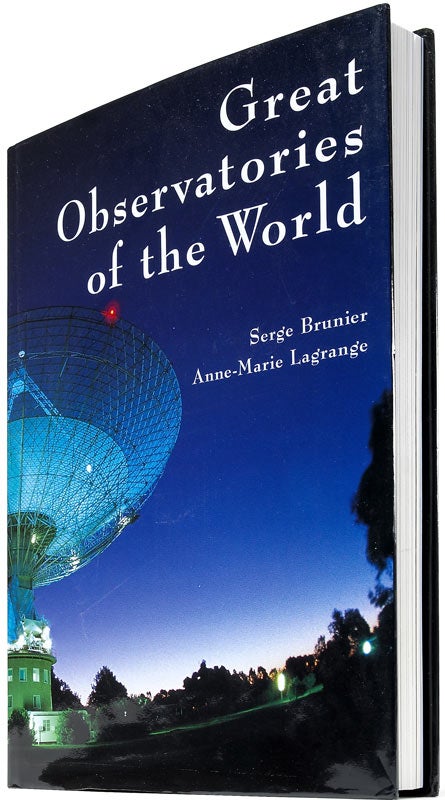Serge Brunier and Anne-Marie Lagrange, translated by Klaus R. Brasch, 240 pages, Firefly Books, 2005, (Originally published by Bordas, 2002); hardcover, $59.95
Approaching an observatory for the first time, often by way of a winding, treacherous road, has always given me a thrill. This book, beautiful in layout, will allow anyone to visit vicariously the world’s major observatories.
The writing, even in translation, is both eloquent and scientifically accurate: “Amid the glaciers and ochre-grey volcanic mounds of Mauna Kea … a sharp metallic groan can be heard in the cold dry air.” There are remarkably few errors. Between the two of us, we have worked on-site at a number of these observatories and could find little to quibble about. A few minor misconceptions are probably translation errors: for example Kitt Peak is I’itoi’s garden, not I’itoi’s home. I’itoi is the deity of the Tohono O’odham (no longer Papago) and is referred to as Elder Brother, not Ancient Brother as the authors write. Brunier and Lagrange give all measurements in metric units, reminding U.S. readers that the rest of the world long ago stopped using a king’s foot as a measurement standard.
| The New Physics for the Twenty-First Century |
| Edited by Gordon Fraser, 556 pages, Cambridge, 2006; hardcover, $60 |
 This excellent textbook features chapters written by 23 physicists in various areas of modern physics. The New Physics is aimed for undergraduate students, but anyone who wants to learn more about physics will enjoy this book. Occasional calculus is included in the text, but most equations are boxed off, and readers who don’t have the needed math background can skip over the equations and still comprehend the science. The first chapter is on cosmology — written by astrophysicists Wendy Freeman and Edward “Rocky” Kolb. Then, the book dives into a wide range of modern physics. Quantum mechanics, chaos theory, condensed matter, biophysics, and science in society are just a few of the topics covered. — Liz Kruesi This excellent textbook features chapters written by 23 physicists in various areas of modern physics. The New Physics is aimed for undergraduate students, but anyone who wants to learn more about physics will enjoy this book. Occasional calculus is included in the text, but most equations are boxed off, and readers who don’t have the needed math background can skip over the equations and still comprehend the science. The first chapter is on cosmology — written by astrophysicists Wendy Freeman and Edward “Rocky” Kolb. Then, the book dives into a wide range of modern physics. Quantum mechanics, chaos theory, condensed matter, biophysics, and science in society are just a few of the topics covered. — Liz Kruesi |
This book is geared for serious amateurs. The observatory visits are interspersed with about 15 mini-chapters, which clearly but briskly cover the basics of light, spectroscopy, telescope mountings, adaptive optics, and also the data analysis that accompanies every observing run. The text assumes the reader has paid attention in these previous science interludes and is at home with terms like terabytes, non-thermal sources, and field flattener.
The index includes names and acronyms for many observatories and telescopes, but terms such as actuator and interferometer are not explained. The appendix has a world map showing the locations of these and other observatories; there is also a figure showing the relative sizes of the 50 largest telescopes (and the smallest is the Hubble Space Telescope).
| The violent universe |
| Kimberly Weaver, 200 pages, The Johns Hopkins University Press, 2005; hardcover, $35 |
 Kimberly Weaver begins this book with an overview of astronomy’s history, the electromagnetic spectrum, and, specifically, the field of X-ray astronomy. The remaining chapters follow the same format: a science explanation followed by images that demonstrate the science. The second chapter discusses stellar lifecycles, and the rest go into the universe’s extreme events — such as the creation of black holes — that emit X-ray radiation. Weaver explains what scientists using X-ray data can learn about black holes and other energetic sources. The images she includes aren’t only of high-energy radiation — there are many visible and radio images to help paint a detailed picture of the universe. Those interested in high-energy astronomy will enjoy this book. Kimberly Weaver begins this book with an overview of astronomy’s history, the electromagnetic spectrum, and, specifically, the field of X-ray astronomy. The remaining chapters follow the same format: a science explanation followed by images that demonstrate the science. The second chapter discusses stellar lifecycles, and the rest go into the universe’s extreme events — such as the creation of black holes — that emit X-ray radiation. Weaver explains what scientists using X-ray data can learn about black holes and other energetic sources. The images she includes aren’t only of high-energy radiation — there are many visible and radio images to help paint a detailed picture of the universe. Those interested in high-energy astronomy will enjoy this book. — L.K. |
Because the original French version was published in 2002, there are a few places where the text is out of date: Yerkes Observatory is sadly no longer in service, and plans for future telescopes — especially space-based — change almost monthly.
One missing feature that would have been helpful is a discussion of the options for visiting these observatories. Many of these sites have well-developed visitor programs, while others are accessible only to the astronomers who have been granted observing time.
The stunning pictures on virtually every page will captivate anyone, encouraging a dip into the book for a few pages at a time. Even the non-astronomer in a household won’t mind displaying this book on the coffee table!
— Katy Garmany is an astronomer at the National Optical Astronomy Observatory (at Kitt Peak, Arizona) now specializing in education outreach. John Glaspey is the Operations Manager at the Multiple Mirror Telescope Observatory (at Mt. Hopkins, Arizona).










